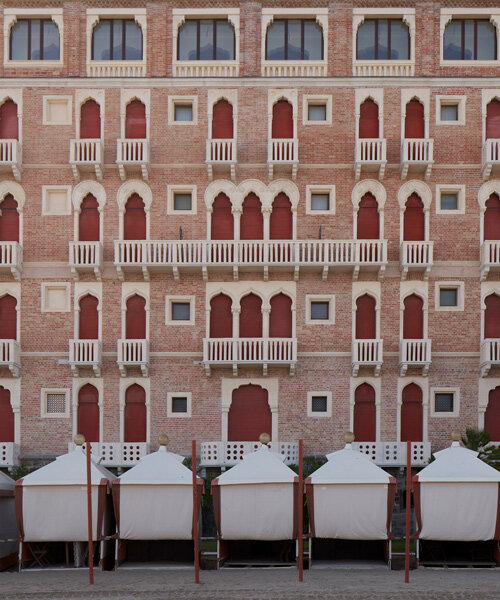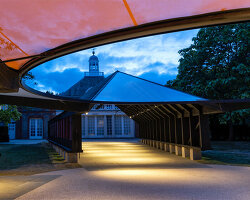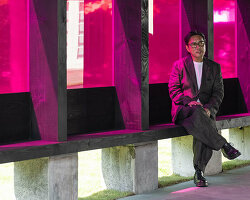born in the heart of post-industrialised germany, photographer nils koenning grew up in a fast changing environment of former coal mining and steel production. inspired creatively by his grandparents — a grandfather who owned an art gallery and a grandmother who was a painter — koenning drew and painted throughout his late teenage years. ‘there was always a keen sense for the visual in me,’ the photographer tells designboom. after studying architecture at university, koenning’s interest turned to documenting the built environment — a practice he developed during his master studies, and later while living and teaching in australia. ‘I learned to question everything the students did and started applying this to my own practice and life in general.’
to learn more about nils koenning’s work, we spoke with the photographer to discuss how he prepares for a shoot, the influence of his current interests, and his ongoing personal projects. read the interview in full below.

ongoing body of work, venice 2014 – 2021 | image © nils koenning (also main image)
designboom (DB): can you start by telling us a little about your background and how you initially became involved in photography?
nils koenning (NK): the school I went to was one of the first rudolf steiner schools in germany. my education there had a strong sense on the practical side of making things as well as a focus on creativity — art, music, drama, etc. I especially enjoyed painting and acting.
another lasting creative influence came from my grandparents’ side — my grandfather owned an art gallery in schleswig at that time and my grandmother was a painter. I drew and painted a lot in my late teenage years. so, when I finished high school, I wanted to study art in berlin at kunsthochschule weißensee. but 3,000 applicants for ten free spaces made me think twice and I applied for architecture in my home town of bochum.
there was always a keen sense for the visual in me. I used cameras since early teenage years, but always snappy, never conscious. I really started to explore photography as a tool and documentation medium consciously throughout my masters degree which focused on communicating architecture.

ongoing body of work, venice 2014 – 2021 | image © nils koenning
DB: we’ve often featured your architectural photography on designboom. have you always been interested in documenting the built environment?
NK: the university I attended had a strong focus on a pragmatic, practical side. making drawings, plans, models, learning how to resolve details etc. was most important. unfortunately the theoretical side and critical analysis were nearly non-existent throughout my diploma.
my interest to document the built environment started to really develop during my master studies and grew stronger during the six plus years I lived in australia and teaching design methodology at the university of melbourne. I learned to question everything the students did and started applying this to my own practice and life in general.

ongoing body of work, austraphobia, australia 2012 – 2021 | image © nils koenning
DB: how do you prepare in advance of a shoot? and what is the first thing you do when you arrive on site?
NK: whenever possible, I take some time to explore the area alone by foot and without a camera first to get a feel for the place. I talk with my clients about their expectations and the way they understand and see the project. I look at existing images, plans and check out the place on google maps to develop an idea about light, angles and times to shoot from.
but my planning is always flexible and adapts to the environmental circumstances — sometimes I take a tripod, other times I shoot hand-held. I don’t have a routine, and I treat each project differently. there’s no one thing that I do when I first arrive on site, but usually I walk.

ongoing body of work, austraphobia, australia 2012 – 2021 | image © nils koenning
DB: how much work takes place after a shoot, before the images are ready to publish?
NK: this depends on the type of project and the way I am documenting it. I do basic corrections like color balance, exposure, straightening and I choose a crop if needed. some pictures also start in my head as I am shooting. if I find a certain angle to be really important for some reason, I spend time waiting for the right elements. this is mostly related to life, people passing by, birds, etc. so these pictures can tell the story of a building through a single image — like this picture I made of the lady cilento children’s hospital in brisbane 2014.

lady cilento children’s hospital, QLD australia 2014 | image © nils koenning
NK (continued): the building is positioned on a large intersection at the end of a lush green and sometimes pink-flowering pedestrian area that follows the river. it’s a place of change, where slow meets fast and a human, pedestrian scale meets a dense urban one. at the time, there was an incredible amount of butterflies migrating past the building. there is an element of surprise, like the group of young asian men looking at the building, but also normal commuters and people following recreational activities, which point toward the notion of change. a pregnant woman in the foreground and an ambulance in the background carry a hint towards the building’s function, and the butterflies and birds feel a bit lost in space.

lady cilento children’s hospital, QLD australia 2014 | image © nils koenning
DB: in addition to your architectural photography, you also have a number of personal projects and series. how do these develop?
NK: very slow at the moment, but I really enjoy this. it’s a different way of working and seeing. when I document architecture my working speed changes a lot — really fast, chasing a group of people in a museum, then waiting at a particular spot for something to change, but it’s nearly always a bit reserved, peeled back. things unfold and I let this happen from a distance.

ongoing body of work, venice 2014 – 2021 | image © nils koenning
NK (continued): with my personal work, I am less restricted by the physical parameters of a place like form and light, so there’s more freedom for thought and interpretation and a lot of the time my way of seeing is more suggestive and close. many of my personal projects are shot manually on large format positive film. this process takes a lot of time and really forces you to slow down and concentrate.

ongoing body of work, venice 2014 – 2021 | image © nils koenning
NK (continued): sometimes it’s just a single image of something special that catches my attention and I want to make a good picture. other projects are long term and have no clear trajectory; they can be fluent and change over time. like my images of venice. I first visited the city in 2014 for the architecture biennale and fell immediately and deeply in love with the place. I started taking pictures at night of the places of tourist worship, but also watched and documented the tourists and their behavior during day-time. but I haven’t really published or showed this work yet, it’s still ongoing and I’m not sure it can ever be finished. when I went to the biennale this year, for example, I used a lot of short film segments and some stills, only working digitally, to document life in venice slowly waking up from the covid slumber. I guess for now I see this as a process of collecting.

ongoing body of work, venice 2014 – 2021 | image © nils koenning
DB: do you have a favorite series that you have photographed?
NK: not really — it’s more about single pictures for me. not every image also works as a great picture on its own and a series functions different than a single image.
there’s for example an image I took in australia. I was obsessed with the way in which the whole country has adopted the north-american model of obsolete rapid-urbanism since the 1950s. my interest and understanding of this is heavily influenced by robin boyd’s infamous book ‘the australian ugliness’ and I believe anyone interested in australian and american urbanism should know this book. so I started to document places and remnants of this past present — a body of work still unfinished. I gave it the working title aboraphobia. the crazy thing is that boyd’s criticism still applies today. knowing the consequences of non-existent public transport and public space, dependency on cars, the immense urban sprawl of a country of abundant space where every single story house is like the next, still baffles me given all our knowledge and technology.

ongoing body of work, austraphobia, australia 2012 – 2021 | image © nils koenning
NK (continued): I was photographing a newly developing area in the small village where my aunt lives and started to put my camera on a tripod, load film, and frame this empty and boring space in between two houses. then all of a sudden a man on a lawnmower appears and starts to mow the lawn on this empty lot in front of me. it was somewhat absurd and of course I took some pictures. to this day I still ask myself what his intention was. why did he mow this patch, did it belong to him, and he wanted his future house to be neat? somehow this grotesquely symbolizes a huge problem in australian society for me.

ongoing body of work, austraphobia, australia 2012 – 2021 | image © nils koenning
DB: overall, is there a particular message or sense that you want your images to convey?
NK: it depends a little on the project and client, but I usually try to convey a sense of unbiased context in my work. I strongly believe architecture cannot exist without emotion. if a place makes me feel a certain way, I will remember this place for the specific emotion, whether good or bad. but if it’s an empty vessel, my memory will erase it quickly. so I try to convey what a place feels like to me through the images.

salk institute for biomedicinal studies, california 2013 | image © nils koenning
DB: what are you currently interested in and how is it influencing your work?
NK: I’ve been watching some of wenders’ early films and fell in love with the ease of his concise way of calm, simple storytelling. especially visually. the normality with which the everyday is treated is really beautiful in my eyes. I also started to work/experiment with film and it feels like being a child again. playground is all yours!
overall though, night-time plays an important role for me. I love the feeling of knowing that everyone else is sleeping. the sounds and shapes of a city night, the freedom of the absence of sunlight, are very poetic and inspiring to me. in the first wave of covid-19, the streets of berlin were swept absolutely empty at 8pm and the foxes roamed free — it was incredible.

brunswick east, VIC, australia 2014 | image © nils koenning
DB: what advice would you give to today’s young and aspiring photographers?
NK: don’t be comfortable and always play. I believe comfort is a killer of innovation and wont help you to develop professionally in any way. make all the mistakes you can and don’t stop questioning your work, medium, beliefs, yourself. play like a child and explore! it’s a life-long process, which never concludes and it’s extremely exciting, satisfying, always challenging, and sometimes devastating.

kensington, VIC, australia 2015 | image © nils koenning
architectural photography (324)
architecture interviews (267)
nils koenning (12)
PRODUCT LIBRARY
a diverse digital database that acts as a valuable guide in gaining insight and information about a product directly from the manufacturer, and serves as a rich reference point in developing a project or scheme.



















